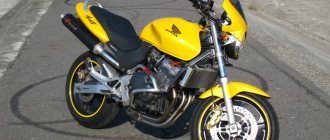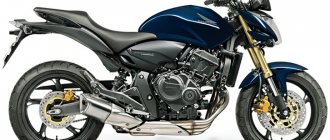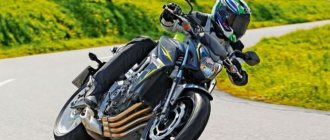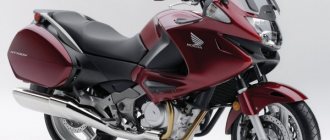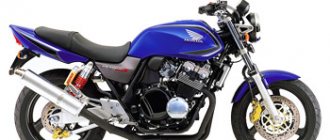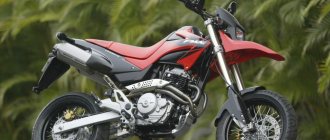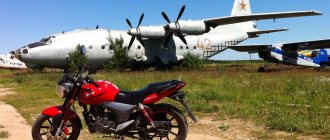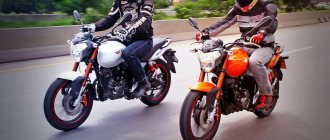- motorcycle model, Honda brand,
The Honda CB 900 F Hornet road motorcycle model appeared in 2002 and was produced until 2007. The motorcycle was built on the basis of a 919 cc inline 4-cylinder engine taken from the Honda CBR919RR Fireblade sports model. This engine was retuned and derated, due to which traction at low and medium speeds was significantly improved, but in the upper range of operation it quickly faded. In addition, from the very beginning, the Honda CB900F Hornet was equipped with fuel injection instead of carburetors.
As noted above, the engine of the Honda CB 900 Hornet motorcycle is a liquid-cooled in-line four with a volume of 919 cc. see, producing 110 hp. at 9000 rpm power and 92 Nm of torque, available at 6500 rpm.
The key features of the Honda CB 900 F Hornet include a steel diagonal frame, simple suspension in the form of a conventional telescopic fork (adjustable - since 2004) and a monoshock absorber (adjustable for preload and then rebound - since 2004), 6-speed Gearbox and conventional cable clutch. Like all Hornet series, the CB900F is a budget motorcycle designed for city riding.
In 2007, the Honda CB 900 Hornet model was discontinued, the main reason for this was the tightening of environmental emission standards. This was a good reason to update the model and introduce a more modern naked bike to the market. It became the Honda CB1000R, built on the basis of the engine from the sports version of the Honda CBR1000RR. The new Honda CB1000R could no longer be called budget, since it used most of the technologies used in full-fledged flagship sports motorcycles - from an aluminum frame and adjustable sports suspensions, to a cantilever swingarm and a combined braking system (C-ABS).
For whom
Here are the main features of the Honda CB 900 F Hornet:
- a design that leaves no doubt that it belongs to the class of road builders;
- dynamic performance is quite good for such a middling vehicle;
- ease of landing.
This model is well suited for those looking for a motorcycle for the city. However, if you install a windshield and other touring equipment, you can get something like a touring version of a road bike.
Engine
The model is equipped with an in-line, four-stroke and four-cylinder engine. Its effective volume is 919 cm³. The unit is cooled by liquid. At 6500 rpm the engine produces a maximum torque of 92 Nm, and at 9000 rpm the maximum power reaches 110 hp. The motorcycle's maximum speed is 230 km/h, and it accelerates to hundreds in 3.2 seconds.
Honda CB900F Hornet
Brief review of Honda CB900F Hornet
The Honda CB900F Hornet is a classic road bike produced since 2002. It is in many ways similar to the first generation Hornet 600 model, but only the name has it in common with the third generation 600 cc younger brother. The fact is that all motorcycles in the Hornet line are fairly budget models without any innovations. This also applied to the Hornet 600, but only at the beginning of its release, since later this motorcycle was “overgrown” with numerous improvements and significantly increased in price.
But the Honda CB900F Hornet was deprived of this. Until its discontinuation (due to stricter environmental standards), this motorcycle was produced without any significant changes, and was a fairly powerful, but structurally very simple model, and perhaps the only serious difference from previous models like the Honda CB 1000 The SF was the injector installed on the Hornet 900.
However, despite this, the model was loved by many motorcyclists, and for good reason. One of the main advantages of the Honda CB900F Hornet is its extremely high-torque engine, taken from the CBR919RR sportbike. The engine was derated, and as a result, it significantly increased traction in the lower and middle speed range, while losing, however, the “tops”. However, the Hornet 900 is a road motorcycle, not a sports motorcycle, so this “motor transplant” operation had a more positive effect on it than a negative one. Be that as it may, this model is still very popular on the secondary market.
Similar motorcycles:
- Suzuki GSF 1200 Bandit
- Yamaha XJR 1300
- Kawasaki Z1000
- Honda CB 1000 SF
Specifications Honda CB900F Hornet
- Years of production: 2002-2007
- Class: road
- Frame: diagonal steel
- Engine: 4-stroke, 4-cylinder, in-line
- Engine capacity, cubic meters see: 919
- Cooling: liquid
- Valves per cylinder: 4
- Fuel supply: injector
- Power: 110 hp (at 9000 rpm)
- Torque: 91.7 Nm (at 6500 rpm)
- Maximum speed, km/h: 230
- Acceleration from 0 to 100 km/h: 3.2 seconds
- Transmission: 6-speed
- Wheel drive: chain
- Front tire: 120/70-17
- Rear tire: 180/55-17
- Front brakes: 2 discs 296 mm, 4-piston calipers
- Rear brakes: 1 disc 240 mm, 1-piston caliper
- Front suspension: telescopic fork with adjustable preload and rebound
- Rear Suspension: Progressive mono-shock with adjustable preload
- Gas tank volume, liters: 19
- Fuel consumption at 110 km/h, liters: ~6.5
- Dry weight, kg: 194
Pros and benefits of the Honda CB900F Hornet
- Excellent traction at low and mid speeds
- High reliability
- Overall balance of all characteristics
- High dynamics
- Good brakes
Pros and cons of the Honda CB900F Hornet
- Weak frame that can be damaged in even a minor accident
- The location of the driver's footpegs is not the most convenient; as a result, every time you brake, your hands are subject to stress
- Heavy weight
- Lack of wind protection
Dimensions and weight
The length of the bike reaches 2125 mm, its width is 750 mm, and its height is 1085 mm. The wheelbase of the motorcycle is 1460 mm, and its seat height is 750 mm. Not including fuel, the Honda CB 900 F Hornet weighs 200 kg. The tank here is quite large - 19 liters, which allows you to use the motorcycle as a touring one, especially since fuel consumption is about 6 liters per 100 km of road.
Chassis and brakes
The classic frame of this motorcycle is made of steel. It fully corresponds to the ideas about the exterior of this class. Alloy wheels look much more stylish than those on many modern road motorcycles. The steering wheel is typical for a niche.
The rear suspension is pendulum, equipped with a monoshock absorber. At the front, it's a 43mm telescopic fork. The rear brake is represented by a single-piston caliper and a 240 mm disc, while at the front there are four-piston calipers and two discs, each 296 mm.
Review of the Honda CB 900 F Hornet motorcycle
My opinion is somewhat specific - I have never driven a car of this class before. Based on reviews from friends, I know some features, but I didn’t notice them on the Hornet. Overall, a very balanced and precise bike, which probably even falls into the “real motorcycle” category. This is what I mean: if a person asks for a device in the salon that is no frills, but reliable, dynamic and controllable, then Hornet is the best option. With a caveat: not for a beginner.
The pilot's seat is classic, upright and comfortable. It wouldn’t even occur to you to ask where something is – everything is where it should be. The engine starts smoothly and runs pleasantly, without vibration or noise. The transmissions “stick” as if on their own, clearly and unambiguously. Moreover, they (with six steps) are surprisingly long. Already on the third you can get everything possible from the motorcycle. What was surprising was the fact that, in the absence of a fairing and glass, the wind blower is not particularly annoying. Only at 190 km/h did I slightly press against the tank. The seating position and position of the footpegs are specific compared to sportbikes (I ride them!). No matter how hard I tried, I couldn’t find a position so that when slowing down I wouldn’t lean on the steering wheel - my hands get tired. You have to hold on to the gas tank and strain your whole body.
His element is the city. Endless trips from one end to the other. The motorcycle is not bad as a traveling vehicle. I had fun "shooting" it. The car rushes away from the traffic lights, “goats up” once or twice and easily rides on the rear wheel, settles down superbly, without a dive, and moves quite briskly between the bumpers. You don’t feel a lack of power, the elasticity of the engine is excellent, you can get underway even in second place. The only thing that is somewhat confusing is the visibility in the mirrors. Not only is visibility not very good, but we also had to get used to their “mobility” - they turn with the steering wheel. I’m used to sportbike “immovable” mirrors. And yet, in the evening on cold asphalt, when braking, the front tire constantly skidded. By the way, this was another reason to check the rigidity of the frame, pendulum and suspension settings - they passed the test with dignity.
In general, not a motorcycle, but a plush toy. But I wouldn’t buy it for myself either as my main or even as a second device. Perhaps as a third... Why? To “fly” there are sports, to do weird things - motards, to deliver pizza or mail there are “hornets”. The latter is not close to me. Once again I want to draw your attention: for all its plushness, the machine does not forgive mistakes. Therefore, people with experience can sit on it.
The device is generally not bad, very good for everyday driving in city traffic. Disadvantages - weak frame, if dropped it will move -95 percent. Weak wind protection - at speeds above 160, discomfort begins. Reluctance to get into wheelies from 2nd gear (in first gear it shoots perfectly both from the gas and from the clutch). It comes out relatively easily in stoppie (with a slight swing of the body - it’s a bit heavy). Pros - excellent steering (it goes all the way to the stops of the footrests). The seating position is comfortable, but if you are taller than 185, the distance to the footrests breaks off (after 150 -200 km). Although I drove 750 a day and it seemed like nothing))). Indestructible engine and gearbox, good dynamics. Forgives some management errors. In general, for everyday driving around the city it’s just right.))
I have a Hornet 900. I like it, but the frame is a bit weak for such a move. And the weight distribution is not the best, I won’t say anything at all about emergency braking... It’s ideal for traffic jams, makes sure you’re on the move (while you’re on the brakes), lightweight, comfortable…. the wind doesn't blow it away! without a case is not an option at all…..there’s nowhere to put the sales case!
So, after almost two weeks and 2 thousand miles, I can say this: I am constantly in awe of this motorcycle.
Yesterday I rode my Sibishka to the metro and back, and I didn’t understand how I even drove it, everything is uncomfortable... the landing, the ergonomics, and the dynamics are generally crap.
After that I went home on the Hornet - heaven and earth. Now I understand what “a motorcycle for people” means, and not those who are 1.5 m tall and weigh 50 kg..... once again I am convinced that the Hornet is pleasant, convenient and comfortable to ride in the city or on the highway. I used to think that only crazy people buy 110-180hp, who constantly run around 250+, but I discovered something unexpected: having a reserve of power under your ass, you behave completely differently, you don’t go where you shouldn’t, you don’t provoke all sorts of stupid things... you just drive calmly and measuredly, and when necessary - zhzhzhzhzhzhzhzh and that’s it, you’re ahead of the rest 
In general, it seems to me that in this motorcycle the Japanese combined sport, cruiser and enduro…. the dynamics, comfort and suspension travel amazes and doesn’t let go every day. I forgot what it means to stand up on sun loungers, etc., small irregularities are generally unnoticeable.
I would like to highlight the consumption: whether on the highway or in the city with speeds up to 150 km/h, a 15 liter tank is enough for 160 miles, i.e. 5-6 liters per stone... I also ate the same thing.
There are many vehicles before that I've ridden that haven't given me as much pleasure as the big Hornet, as the Hemulen said, “it's fun to ride and ride” (c)
